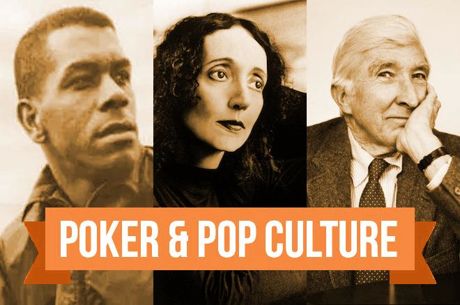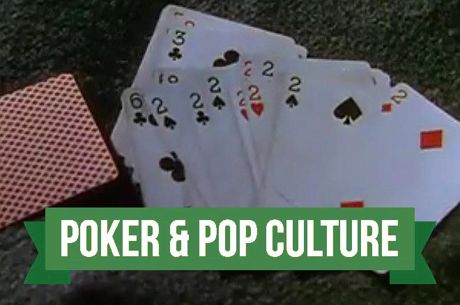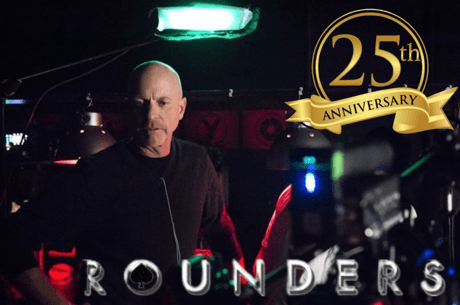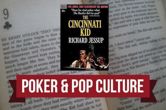Poker & Pop Culture: The Great Tuesday Night Game Trilogy

Continuing this mini-survey of late 20th-century poker-related literature, among the handful of "must read" narratives produced during the period are three books authored by participants in the same north London home game.
David Spanier was a foreign and diplomatic correspondent for The Times and later a reporter for other outlets. having written a well regarded book about Britain's entry into the European Common Market.
Al Alvarez's background was literary, including his serving as the poetry editor for The Observer. He also wrote his own poetry, fiction, nonfiction, and critical essays. By the time his first poker book appeared, Alvarez had published extensively, mostly about poetry and poets as well as on other topics.
Meanwhile Anthony Holden had written a number of biographies of Royal Family members, translated Greek poetry and operas, and would go on to write on numerous other non-poker subjects including biographies of William Shakespeare and others.
All three additionally shared a dedication to poker, as noted having participated in the same Tuesday night game. Each in turn produced what have since become highly recommended works not just for poker enthusiasts, but for fans of excellent, insightful prose, generally speaking.
David Spanier, Total Poker (1977)
First published in 1977, Spanier's Total Poker is a collection of essays that approach the subject of poker from a variety of perspectives, thereby demonstrating the richness of the game and its seemingly endless capacity to produce stories, emotions, ideas, and even life lessons. One way to characterize the book would be to call it an "anatomy" of poker �� a close, minute examination of the subject from multiple angles.
The first of the book's chapters �� simply titled "Bluff" �� all by itself shows Spanier taking various approaches to his chosen topic.
He starts out discussing the "classical approach" using examples from Herbert O. Yardley's The Education of a Poker Player, the James Jones novel From Here to Eternity, and The Cincinnati Kid (both the film and the novel, the latter of which was discussed last week).
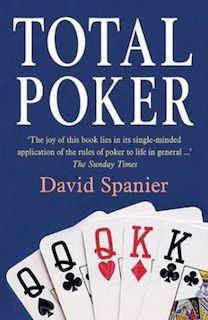
He next focuses on Muhammad Ali's use of bluffing in his famous "Rumble in the Jungle" heavyweight title bout versus George Foreman in Zaire. From there he shares others' efforts to explain bluffing from psychological and even physiological points of view. He then concludes with a brief discussion of stud hi-lo, arguing how, in his opinion, split games are where bluffing "achieves its fullest complexity."
The next three chapters are more historical, looking at the origins of poker, the legacy of U.S. presidents' frequent association with the game, and a character sketch of Puggy Pearson. There follows an homage to America's gambling capital, titled "Breakfast in Vegas," a look at women in poker titled "Loving and Losing," and a chapter on poker in the movies in which he interestingly positions The Hustler �� a movie about pool, not poker �� as the best example of a film teaching lessons about poker.
Spanier then moves over to address various psychological and moral issues associated with poker. "The Old, Old Story" humorously dramatizes poker's ability to make us lie to ourselves. "Funny Game" explores an example of cheating in poker. And "Morals" considers that strange formula with which we are all at least somewhat familiar that suggests becoming a winning player requires one to care less about the welfare of others.
"A fine line is drawn between the status of amateur and professional at poker," Spanier writes. "Really it's a moral line. How far do you go, how much do you play, how much do you want to win?" That's just one of many examples of observations encouraging poker players to think more deeply about why they play.
The book then concludes with a chapter called "Ends and Odds" which is peppered with probability tables and observations about particular games.
Spanier says in the Preface to Total Poker that "one of the things [he] discovered in writing this book is how deep a subject poker is: one can't really ever get to the boundaries of it; like exploring space, there's always farther to go." Such is a lesson his reader discovers as well.
Al Alvarez, The Biggest Game in Town (1983)
I assign a few excerpts from Total Poker in my American Studies course "Poker in American Film and Culture." Meanwhile I have the students read all of The Biggest Game in Town by Al Alvarez, a book that more than three decades after its initial publication remains a gold standard of poker reporting. Much more than just a comprehensive account of the 1981 World Series of Poker, the book provides an illuminating portrait of America that transcends the card games at its heart.
The first chapter alone highlights several themes that connect poker and American culture. Beginning at Binion's Horseshoe, Alvarez initially lingers over the old seven-foot-high, million-dollar display that once stood outside the casino like an ostentatious, garish shrine affirming Americans' devotion to the almighty dollar. The collection of $10,000 bills under glass strikes Alvarez as emblematic of "the perennial dream of the Las Vegas punter visible to all, although not quite touchable."?
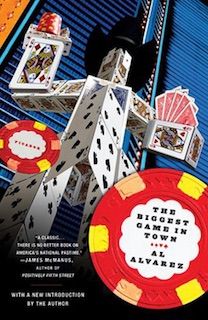
From there Alvarez moves inside the casino to observe and comment on the rituals of the game as well as what he'll later call "the differing ordering of reality" recognized by those who play poker at the highest stakes. He also finds room to speak of both the artificiality and eclecticism of Las Vegas, "the logical conclusion of what is for the foreigner one of the eeriest aspects of America: the utter lack of continuity between the large towns and their surrounding countryside."?
Alvarez has more to say about America and its values and how he sees those values illustrated in the oddly-formed, patchwork landscapes of the country as a whole and Vegas in particular. It's not all flattering, of course, with certain "American" values of self-reliance and independence at times shading over into self-interest and even indifference.
After that initial chapter, the book carries the reader on a remarkable journey covering the history of poker and the WSOP, neatly leading up to the final couple of chapters that describe Stu Ungar's victory in the 1981 WSOP Main Event.
Along the way Alvarez shares the thoughts of many players and others regarding the game, deftly weaving into the story fascinating conversations with Jack Binion, Johnny Moss, Mickey Appleman, Chip Reese, Eric Drache, Bobby Baldwin, Doyle Brunson, Jack Straus, David Sklansky, and many others.
The many themes covered include that "different ordering of reality" by high-stakes players mentioned before, thinking of poker as "work" (as opposed to "play"), attitudes towards poker and gambling and the larger's culture's acceptance (or non-acceptance) of the game, talk of the "straight world" or they "system" (and desires to escape it), and as noted the many ways so-called "American" values can be said to be reflected by poker and the WSOP.
Such a summary gives you an idea of what the book covers, but doesn't give an indication of Alvarez's powers of description and depth of understanding �� how he manages to bring a poet's insight to what might seem from the outside a prosaic subject.
Suffice it to say, in terms of both style and substance, A.A.'s book is aces.
Anthony Holden, Big Deal (1990)
The critical and commercial success of Spanier's Total Poker is said to have encouraged Alvarez to pursue with his agent the deal that got him a job to cover the 1981 WSOP for The New Yorker, a trip that eventually resulted in The Biggest Game in Town. So, too, did Alvarez's book directly inspire Anthony Holden to do something similar a few years later, although rather than just visit the WSOP and talk to other poker pros about what they do, Holden decided to give the full-time poker-playing thing a go himself.
Big Deal tells the story of Holden's year-long investigation to see if he might, perhaps, be able to escape the so-called "straight" life and become a full-time poker player. It's a smart, well-crafted narrative, with tons of insight into the professional poker scene (circa late 1980s), poker history, and the psychology of poker. It's a page-turner, too, as Holden does a nice job building suspense regarding that ultimate decision whether or not to turn pro for real.

The book has had a couple of subtitles attached to it. Initially it was "Confessions of a Professional Poker Player," though revised to "A Year as a Professional Player" as a better indication of the scope of Holden's experiment and subsequent chroncling of it.
Both Spanier and Alvarez appear in Holden's book, with Spanier there at the start alongside Holden as the pair both play the media tournament at the 1988 WSOP. After that Holden takes a shot at the "Big One" �� the Main Event �� where he finished in the middle of the pack among 167 entrants. After that comes a year-long study in which Holden plays home games (including the aforementioned Tuesday night game), cash games in casinos, and various tournaments around the world with a return trip to the "Big One" the following year his ultimate destination.
Alvarez is one of a few of the supporting cast for Holden's adventure, playfully named the "Crony" here. Also appearing is his wife, called the "Moll," who helps to remind the reader of the larger life context for Holden's trial, and his psychiatrist, the "Shrink," whose appearance allows Holden to flesh out some compelling theories about the reasons why we humans have such an urge to gamble.
Holden's book is more personal and subjective than either Total Poker or Biggest Game, although both Spanier and Alvarez also incorporate a lot of their own experience with poker into their studies. But Holden also neatly covers a lot of important episodes and anecdotes from poker history along the way �� e.g., enlightening detours to address The Cincinnati Kid, Fyodor Dostoevsky's The Gambler, as well as discussion of how poker and other "games of chance... have played so large a role in the development of the American character."
Holden additionally manages to deliver some of the more memorable aphorisms about poker ever articulated, likely forcing most readers frequently to reach for a pencil for the purpose of underlining.
For example, early on he notes having learned "two amateur truisms that a spell as a professional will quickly disprove: that losing is always the fault of the cards, never the player; and that the person who beats you is either lucky or a fool."
Near the end, he wistfully compares leaving the card games of Las Vegas and California to "that familiar rage about the prospect of death �� that the world will have the nerve to carry on without me, and I will never know who won and who lost."
And, of course, there's the book's most-quoted passage, and probably one of the most frequently shared poker quotes ever since it first appeared:
Whether he likes it or not, a man's character is stripped bare at the poker table; if the other players read him better than he does, he has only himself to blame. Unless he is both able and prepared to see himself as others do, flaws and all, he will be a loser in cards, as in life.
The story ends with Holden trying once more and again not winning the WSOP Main Event, though it's obvious he's profited immensely nonetheless.
Conclusion
All three authors would write more about poker (while continuing to pursue their wide-ranging non-poker interests).
Appearing after several other books about gambling, Spanier's The Hand I Played: A Poker Memoir (published in 2000, the year of his passing) collects more essays about the game, including a long, satisfyingly deep dive into the famous home game titled "Tuesday Night." Alvarez's Poker: Bets, Bluffs and Bad Beats (2001) is an especially fun history replete with hundreds of photos and illustrations that further make it a great add to any poker player's library.
Holden produced a couple more poker titles �� a sequel called Bigger Deal (2007) that provides a detailed look into the post-"boom" world of professional poker, and Holden on Hold'em (2008) which combines strategy talk with more entertaining observations (see a review of the latter here).
If you've only read one or two (or none) of the "Tuesday Night Game trilogy," though, I'd recommend starting with those to learn more about poker's history and why it remains a favorite game of so many.
From the forthcoming "Poker & Pop Culture: Telling the Story of America's Favorite Card Game." Martin Harris teaches a course in "Poker in American Film and Culture" in the American Studies program at UNC-Charlotte.

